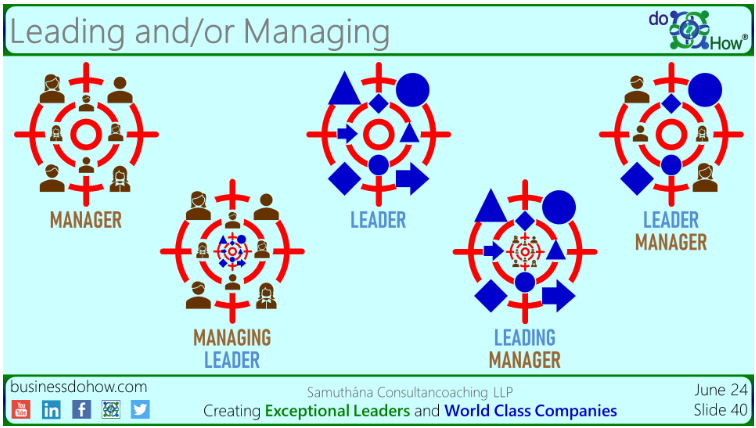Thriving in the Present and Shaping the Future: The Synergy of Leading and Managing

Success in any organization depends on two primary objectives: thriving in the present and shaping the future. These goals necessitate creating value for all stakeholders, including family, friends, community, government, regulators, creditors, financers, shareholders, management, peers, colleagues, reportees, customers, clients, suppliers, vendors, and partners.
While some argue that managing is crucial for present success and leading is essential for future growth, I believe both are inseparable and equally important. Leading and managing are two sides of the same coin – success. People can be categorized as leaders, managers, leading managers, managing leaders, or leader-managers. Consider which group you belong to as you read on.

Leadership and Management: Core Differences
Leading is about:
- Effectiveness
- Creativity
- People-centric actions
- Creating a shared purpose
- Inspiring trust and commitment
Managing is about:
- Efficiency
- Discipline
- Systematic actions
- Setting SMART goals
- Detailed planning and execution
- Regular reporting and review
Great leaders inspire with vision and imagination, while great managers excel in disciplined execution. Successful entrepreneurs and CEOs embody both roles. This insight comes from my 40 years of experience in India, Brazil, and Germany, working closely with people from France, Austria, Italy, Czechia, Türkiye, USA, and Japan.
Societal Differences in Leadership and Management
Developing societies often struggle with management, facing execution challenges like unclear roles and targets, and lack of regular reporting. In contrast, developed societies and multinationals typically have strong management but require creative solutions for strategy and employee engagement.
The German Perspective
The German words “fördern” (encourage) and “fordern” (demand) describe leadership and management well. A good leader delegates by encouraging, and a good manager demands accountability.
Levels of Delegation and Accountability
- Level 1: Task-Based Delegation
- Delegation: Assign specific tasks with clear instructions.
- Accountability: Proactively complete tasks, seeking help if needed.
- Level 2: Context-Based Delegation
- Delegation: Explain the context and benefits behind tasks.
- Accountability: Overcome challenges to complete tasks.
- Level 3: Decision-Inclusive Delegation
- Delegation: Involve team members in decision-making.
- Accountability: Recommend improvements and seek approval.
- Level 4: Empowerment-Based Delegation
- Delegation: Empower team members to make decisions within set boundaries.
- Accountability: Understand scope and decision boundaries for task completion.
- Level 5: Autonomy-Based Delegation
- Delegation: Entrust entire projects with autonomy.
- Accountability: Ensure outcomes satisfy all stakeholders.
Types of Leaders and Managers
- Just Leaders or Managers: Either delegate by encouraging or demand accountability.
- Leading Managers: Delegate at higher levels while demanding at lower levels.
- Managing Leaders: Delegate at lower levels while demanding at higher levels.
- Leader-Managers: Delegate and demand at the same level, working synergistically with their teams.
Importance of Both Competencies
Leadership and management competencies are essential, especially for transformation. Initiating and implementing transformations are necessary for thriving in the present and shaping the future, often critical for survival.
Reflect on whether you are a leader, manager, leading manager, managing leader, or leader-manager as you continue your journey towards balanced success.






Responses